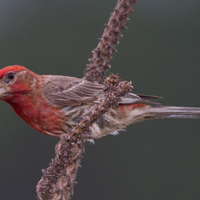Login
Subscribecolor, evolution
Gene Regulation Gives Butterflies Their Stunning Looks
Katarina Zimmer | Nov 14, 2019 | 5 min read
Distantly related, lookalike Heliconius species arrive at the same appearance using the same few genes, but regulated differently, according to recent studies.

Image of the Day: Red-Feathered Finches
Emily Makowski | Sep 30, 2019 | 1 min read
Scientists uncover a potential reason why redder house finches have better health.

Hawaiian Spiders on Different Islands Evolved Same Disguise in Parallel
Catherine Offord | Mar 8, 2018 | 2 min read
In an unusual evolutionary twist, local stick spiders have come up with an almost identical repertoire of color morphs in multiple locations.

The Rise of Color
Jef Akst | Jul 1, 2014 | 1 min read
An analysis of modern birds reveals that carotenoid-based plumage coloring arose several times throughout their evolutionary history, dating as far back as 66 million years ago.
Dinosaurs’ Shiny Black Feathers
Cristina Luiggi | Mar 9, 2012 | 1 min read
A 130 million-year-old winged dinosaur offers scientist the oldest evidence of iridescent feathers.
How the Zebra Got Its Stripes
Jef Akst | Feb 9, 2012 | 2 min read
Zebras may have evolved their striped coat to avoid blood-sucking flies.
